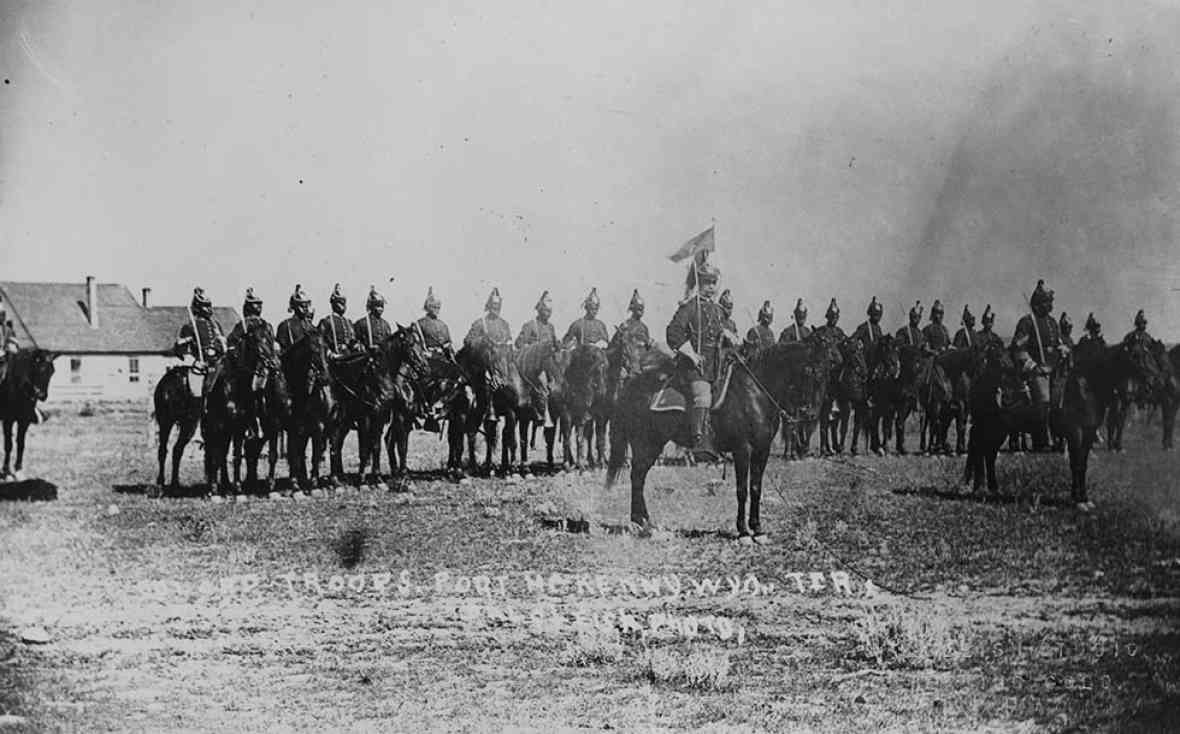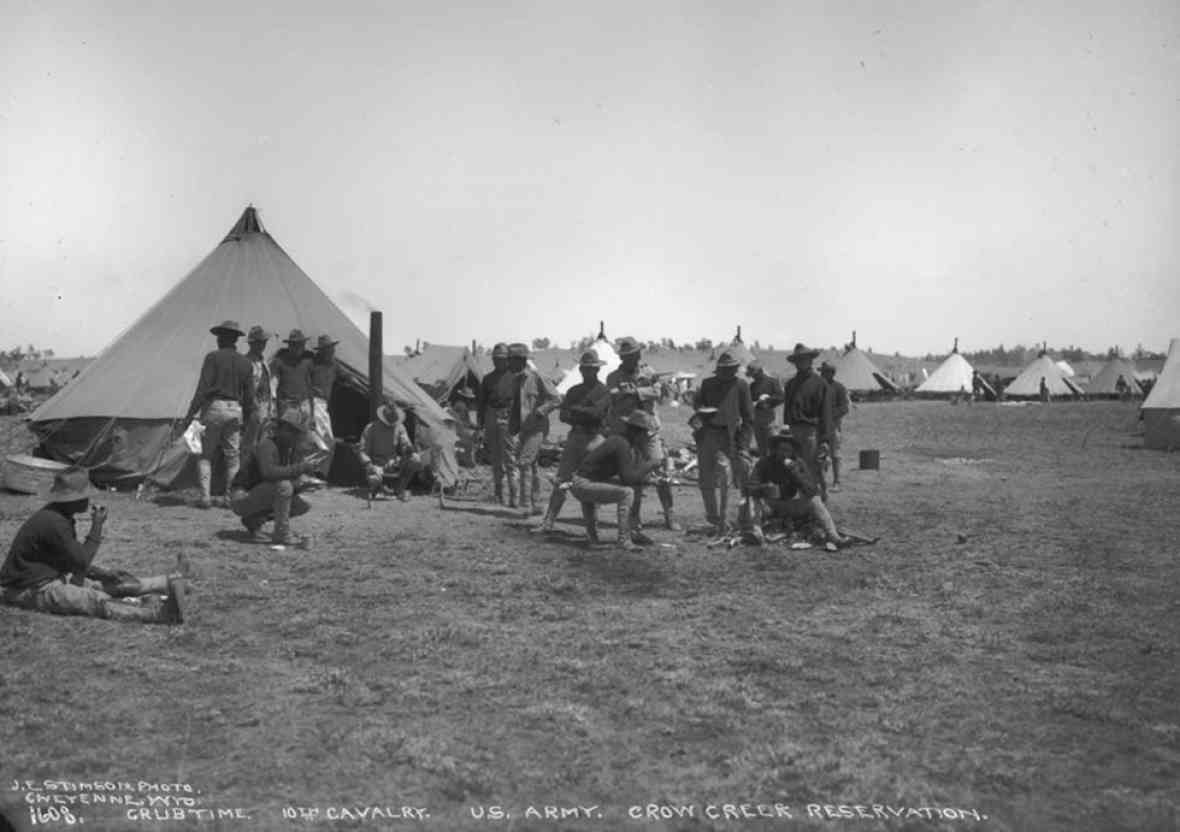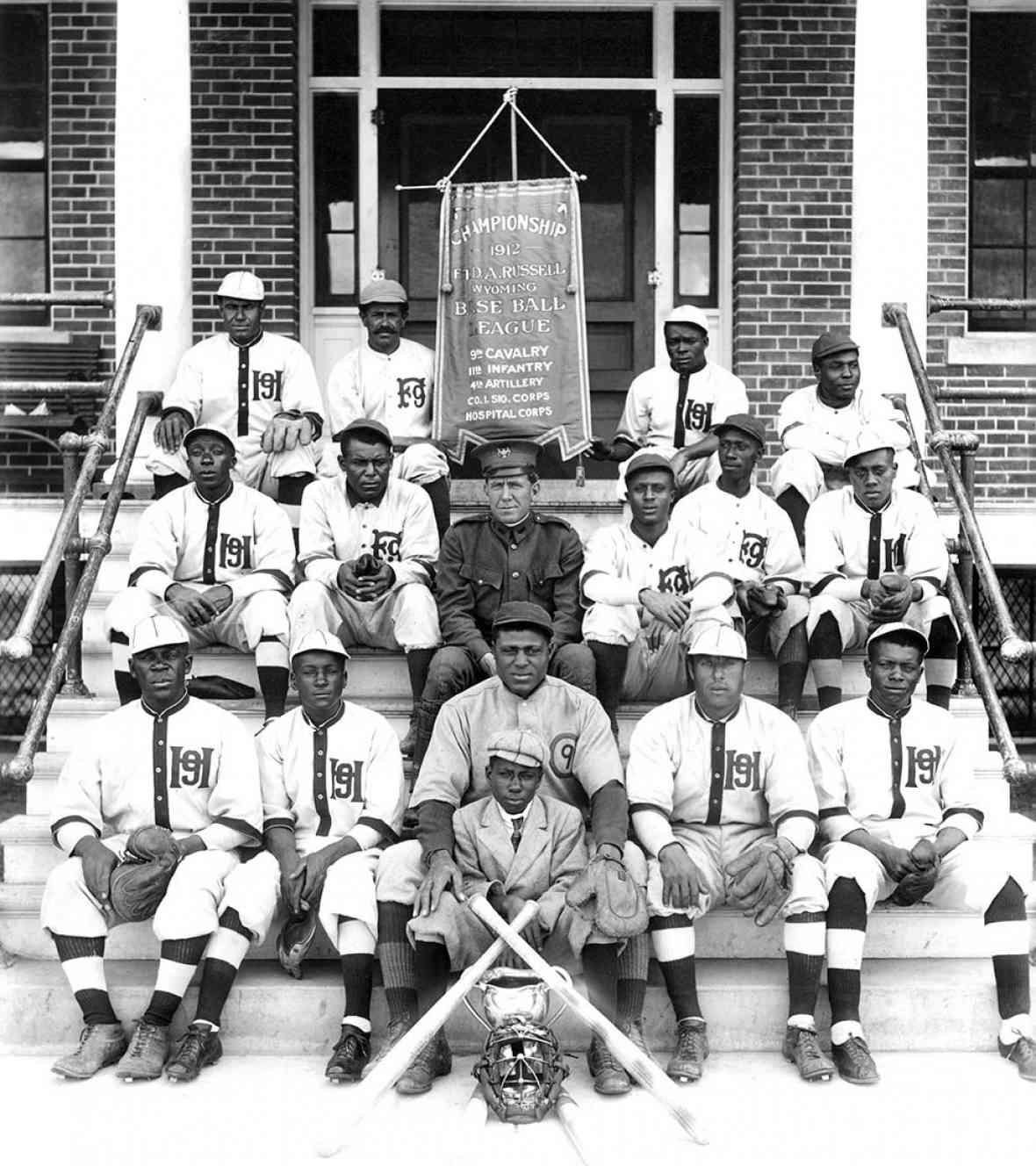- Home
- Encyclopedia
- Buffalo Soldiers In Wyoming and The West
Buffalo Soldiers in Wyoming and the West
After the Civil War, about one-fifth of the regular U.S. cavalry troopers in the West—around 1,500 soldiers at any one time—were Black. These troops of the 9th and 10th cavalry regiments patrolled constantly in the Southwest from 1867 through the 1880s, in what are now Kansas, Oklahoma, Texas, Colorado, New Mexico and Arizona.
Their job was to keep order among buffalo hunters, whiskey peddlers, cowboys, horse thieves, comancheros, townspeople, Mexican bandits and revolutionaries, homesteaders—and highly mobile bands of Kiowa, Comanche, Cheyenne, Arapaho, Kickapoo and Apache warriors, whose raids grew more daring and desperate as their food source, buffalo, was hunted to near extinction.
In the early years, most soldiers of the 9th and 10th had previously been enslaved. Many had served among the 179,000 U.S. Colored Troops on the Union side in the Civil War.
The life was harsh and the food meager. Racial prejudice was a chronic plague. Still, the troops fought gallantly and well. The 9th and 10th had the lowest desertion rates of any of the cavalry regiments in the West. Twenty-three Black soldiers won the Medal of Honor between 1870 and 1898.

The buffalo soldier name
American Indians of the Southwest appear to have begun calling Black troops of the 9th and 10th cavalry Buffalo Soldiers. To the tribes, the soldiers’ hair looked like the hair of buffaloes: dense and curly. But the soldiers knew, too, that the buffalo was sacred to the Indians for its strength and courage.

According to one account, word spread among the tribes in 1867 after Pvt. John Randall, Troop G, 10th Cavalry, armed only with a pistol and despite multiple wounds, fought like a cornered buffalo against 70 Cheyenne warriors until help arrived. The troops of the 9th and 10th were happy to accept the name. The 10th included the image of the buffalo on its coat of arms, adopted in 1911, and made it more prominent on insignia adopted in 1922.
During the Indian Wars, the term spread quickly to include the Black soldiers of the 24th and 25th Infantry regiments. It expanded further from the time of the Spanish-American War through the two world wars to include all African-American soldiers in the U.S. Army.
Buffalo soldiers in Wyoming
After the tribes of the northern plains were subdued in the late 1870s, the War Department gradually moved the 9th and 10th cavalry north to forts in Wyoming, Montana, Utah, Nebraska and the Dakotas.
During that time, trouble broke out between Utes at the White River Agency in northwest Colorado and their naïve, overzealous agent, Nathan Meeker. In the fall of 1879, he pleaded for military help. The Army sent three troops of the all-white Fifth Cavalry, a company of the Fourth Infantry and a 25-wagon supply train under Major Thomas Thornburgh from Fort Fred Steele, on the Union Pacific line near Rawlins, Wyoming Territory. They confronted a band of Utes on the Milk River in Colorado, 15 miles east of the agency. Shots rang out, the soldiers circled the wagons and soon found themselves under heavy fire from warriors on bluffs above them. Thornburgh and 12 soldiers were killed within the first few minutes, and a long siege began.
Just 70 miles to the south, the veteran, 35-man Troop D of the 9th Cavalry under Capt. Francis Dodge learned of the siege from a courier. Dodge issued three days rations and extra ammunition. Traveling fast without wagons, they covered the 70 miles in 20 hours, arriving before daylight. The Black 9th Cavalry troopers joined the trapped soldiers in their rifle pits behind breastworks of dead horses, enormously boosting morale.
“[W]e took those darkies in right along with us in the pits. We let ‘em sleep with us, and they took their knives and cut off slips of bacon from the same sides as we did,” one of the White troopers, apparently surprised at the weakening of his racial prejudice, later told the New York Herald.
The siege lasted four days. Sgt. Henry Johnson of the 9th later won the Medal of Honor for risking his life to bring water from the river to the thirsty soldiers, many of them wounded. On the morning of Oct. 5, Col. Wesley Merritt arrived from Fort Steele with five more troops of the Fifth Cavalry. The Utes left, and all the troops headed back north toward the railroad and into Wyoming Territory.
Troop D reached Fort Steele on October 19. On borrowed horses to replace the ones killed by Utes, they rode into the fort between two lines of White soldiers. Dodge, exhausted, dismounted and gave a crisp salute to the colonel of the garrison, who, in reply, lifted his hat and started a round of applause from everyone there.
Still mounted, the rest of the buffalo soldiers saluted in return, and “nearly every one of them bowed with real grace in acknowledgement of their greeting,” the Army and Navy Journal reported. It was one of few times in the West when buffalo soldiers won public recognition from White authorities for their soldiering. They returned by rail to New Mexico, stopping in Denver on the way where they were greeted by Colorado Gov. Frederick Pitkin and a crowd of enthusiastic people from the Black community there.
Buffalo Soldiers in the Johnson County War
In April 1892, a 52-man army of members of the Wyoming Stock Growers Association and hired Texas gunmen invaded Johnson County, Wyo., intending to kill men they believed to be rustlers—cattle thieves and malcontents. They murdered two men, but soon found themselves surrounded by a posse of as many as 400 men led by Johnson County Sheriff Red Angus. The White 6th Cavalry from Fort McKinney lifted the siege and escorted the invaders to safety in Cheyenne to await trial. Months of legal wrangling followed, all charges were eventually dismissed and both sides were left feeling they had unfinished business.
After the invasion, members of the Stock Growers Association pressured the federal government to declare martial law. Partly this was because they feared rustlers, many of them former Texas cowboys, would seek revenge, but also because, apparently, the invaders anticipated manipulating federal troops into finishing the job they had begun. Six members of the Association declared in a cable to Wyoming’s U.S. Senator Joseph Carey: “…The colored troops will have no sympathy for Texan thieves, and these are the troops we want …”
The War Department sent 310 men of the 9th Cavalry from Fort Robinson, Neb., to establish a camp near Suggs, by the Powder River, an end-of-tracks vice town—made up primarily of bars, brothels and gambling houses—on the Burlington Railroad. The Burlington that summer was building from Gillette toward Sheridan. The troops arrived June 13, 1892.
Accompanying the troops was Phil DuFran, a former city marshal in Buffalo and now a detective for the Stock Grower’s Association, who had been one of the invaders of Johnson County two months earlier. His presence was known to the so-called rustler element in Suggs, and made them see the 9th Cavalry troopers as agents of the invaders.
Off-duty Black soldiers in Suggs were refused service in stores and barbershops and met by open threats, taunts and insults. An argument in a saloon over a prostitute led to an armed confrontation between two Black troops and White locals; the Black men were shot at as they rode back to the camp on a single horse.


The next night, June 17, 1892, 20 or more troopers slipped out of camp and returned to Suggs. The soldiers began shooting, locals returned fire, and one soldier was killed. Two companies were sent from the camp to restore order. There was an investigation, and the Army banned the troops from town for the rest of the summer. The regiment returned to Fort Robinson in the fall.
“The injustices sustained by the regiment,” historian Frank Schubert argues, “grew out of the expressed desire of the Wyoming stockgrowers to take advantage of racial prejudice, to use the hatred that existed between the ‘Texan thieves’ and the cattlemen.”
The entire event, together with the death of one of the troopers, was hard on the 9th Cavalry’s morale and self-respect. Given the extreme tensions in northern Wyoming at the time, the results could have been far worse.
Buffalo soldiers at Fort D.A. Russell, Cheyenne
Fort D.A. Russell was established west of Cheyenne in 1867, garrisoned with cavalry and infantry. The first Black troops stationed near the fort were Troop K of the 9th Cavalry, sent to Wyoming in 1887 by President Grover Cleveland to protect federal employees who were removing illegal fencing. In September 1898, four companies of the Black 24th Infantry, fresh from combat in the Spanish-American War in Cuba, were posted at the fort.
Troop E of the 10th Cavalry was stationed at the fort in 1902. They were just back from the conflicts in the Philippines between U.S. troops and Filipino guerillas, which stretched on for years after the U.S. victory over Spain in 1898. Soldiers from Troop E participated in Frontier Days that July, in a dramatic, staged rescue of a stagecoach from “hostile” Indians—actually Shoshone and Arapaho volunteers from the Shoshone Reservation in Fremont County. These were peacetime years, and the soldiers were fairly well received by the people of Cheyenne.
The 9th Cavalry arrived at Fort D.A. Russell in 1909. A year later the 9th was sent to the Mexican border in response to instabilities from the growing Mexican Revolution, but returned to Fort Russell after a few months. The 9th was again sent to the border in September 1912. The 24th Infantry returned to Fort Russell in 1916 after an absence of many years, but stayed only a month before that regiment, too, was sent to the border in response to raids into Arizona by Mexican irregulars under Pancho Villa.
Buffalo soldiers in the West and around the world
The 9th and 10th cavalry and 24th and 25th infantry regiments served valiantly, as we have seen, in heavy combat in Cuba in 1898 in the Spanish-American War. Units of those regiments served as well in conflicts in the Philippines in the next few years, and on the Mexican border in 1916.
Most of the Black troops’ service was stateside and peaceful. Yet it continued to be plagued by racial strife. Many incidents began like the one in Suggs, with violent harassment by whites in town leading to retaliation by larger groups of armed, Black troops.
Racial tensions involving troops of the 25th Infantry recently stationed near Brownsville, Texas, in the summer of 1906 led to the death of one Black soldier and two White citizens. In a second incident, a White bartender was shot to death and a Hispanic policeman wounded. Though the soldiers and their White officers protested that they had not been involved at all in the second incident, President Theodore Roosevelt ordered 167 of them dishonorably discharged. This meant loss of their pensions and no chance at any future federal employment.
In 1917, violence against Black troops by the police of Houston, Texas, provoked 100 or more soldiers of the 24th Infantry to mutiny and charge the city. Fifteen whites were killed, including four policemen, and four Black soldiers were killed. The Army brought charges against 118 Black soldiers. Twenty-nine were hanged, 53 were sentenced to life in prison, seven were acquitted, and the rest served prison terms of two to 20 years.
Despite the evidence of the previous 50 years, the War Department decided black troops were unfit for combat. Almost no Black troops saw combat in World War I and few in World War II. Three of the four Black regiments were deactivated after World War II.
The Army began desegregating in 1947, but when the Korean War broke out in 1950, the 24th Infantry was still an all-Black unit. Again, trouble led to national notoriety when Lt. Leon Gilbert, a Black man, refused an order from a White superior officer to lead 12 exhausted men back into deadly, almost point-blank machine-gun fire. Gilbert was tried and sentenced to death. President Truman commuted the sentence, and Gilbert eventually served five years.

Resources
- Adams, Gerald M. The Post Near Cheyenne: A History of Fort D.A. Russell, 1867-1930. Boulder, Colo.: Pruett Publishing Company, 1989.
- Brown, Barnum and J.P. Sams. A Triceratops Hunt in Pioneer Wyoming, ed. by Michael F. Kohl, Larry D. Martin and Paul Brinkman. Glendo, Wyo.: High Plains Press, 2004, 106-107; 132-135, 161 n. 73. Includes an account of the events of July 1895, when a white posse killed a Bannock Indian in Jackson Hole, Wyo., and four troops of the 9th Cavalry were sent to Fort Washakie near Lander, Wyo., in response.
- Buecker, Thomas R. Fort Robinson and the American West, 1874-1899. Norman, Okla.: University of Oklahoma Press, 1999. See pp. 169-180 for the role of the 9th Cavalry, including Troop D from Fort McKinney, Wyo., in the 1890-1891 Pine Ridge campaign against the Lakota Sioux.
- Dobak, William A. and Thomas D. Phillips. The Black Regulars, 1866-1898. Norman, Okla.: University of Oklahoma Press, 2011, xi-xviii, 90-113. Thanks to Texas historian Henry B. Crawford for alerting us to this title, which does a good job of locating its topic in the context of broad-based logistical concerns facing the Army at the time. Originally this article included the sentence, "They [troopers of the 9th and 10th Cavalry] had to make do with aging horses and worn-out equipment cast off by more prestigious—and white—regiments like the 7th Cavalry. Dobak and and Phillips in Chapter 5 make a convincing argument that this was not the case.
- Fowler, Arlen L. The Black Infantry in the West, 1869-1891. Foreword by William H. Leckie. Westport, Conn.: Greenwood Publishing Corporation, 1971, 68-69 for the Pine Ridge campaign.
- Edgerton, Robert B. Hidden Heroism: Black Soldiers in America’s Wars. Boulder, Colo.: Westview Press, 2001.
- Kenner, Charles L. Buffalo Soldiers and Officers of the 9th Cavalry, 1867-1898: Black and White Together. Norman: University of Oklahoma Press, 1999, 66-71.
- Leckie, William H. The Buffalo Soldiers: A Narrative of the Negro Cavalry in the West. Norman, Okla.: University of Oklahoma Press, 1967.
- Murray, Robert A. “The United States Army in the Aftermath of the Johnson County Invasion,” Annals of Wyoming 38, no. 1 (April, 1966) 59-75. Republished in Carroll, John M., ed. The Black Military Experience in the American West. New York: Liveright Publishing Corporation, 1971, 443-459.
- Schubert, Frank N. Black Valor: Buffalo Soldiers and the Medal of Honor, 1870-1898. Wilmington, N.C.: Scholarly Resources, Inc., 1997, 61-72.
- _______________. “The Suggs Affray: The Black Cavalry in the Johnson County War.” The Western Historical Quarterly 4, no. 1 (1973), 57-68.
- _______________. "Black Soldiers on the White Frontier: Some Factors Influencing Race Relations,” in Glasrud, Bruce A. and Michael M. Searles, eds. Buffalo Soldiers in the West: A Black Soldiers Anthology. College Station: Texas A&M University Press, 2007; 176-184. First published in Phylon 32 (1971), 410-15.
- Taylor, Quintard. In Search of the Racial Frontier: African Americans in the American West, 1528-1990. New York: W.W. Norton & Co., 1998. Chapter 6, “Buffalo Soldiers in the West, 1866-1917,” is an excellent big-picture overview of Indian combat, civil conflicts and of the troopers’ private and family lives.
Illustrations
- The 10th Cavalry coat of arms and insignia are from Wikipedia. Used with thanks.
- The photo of the mounted, helmeted troops of the 10th Cavalry at Fort McKinney is from the American Heritage Center. Used with permission and thanks.
- The rest of the photos are from the Wyoming State Archives. Used with permission and thanks.
